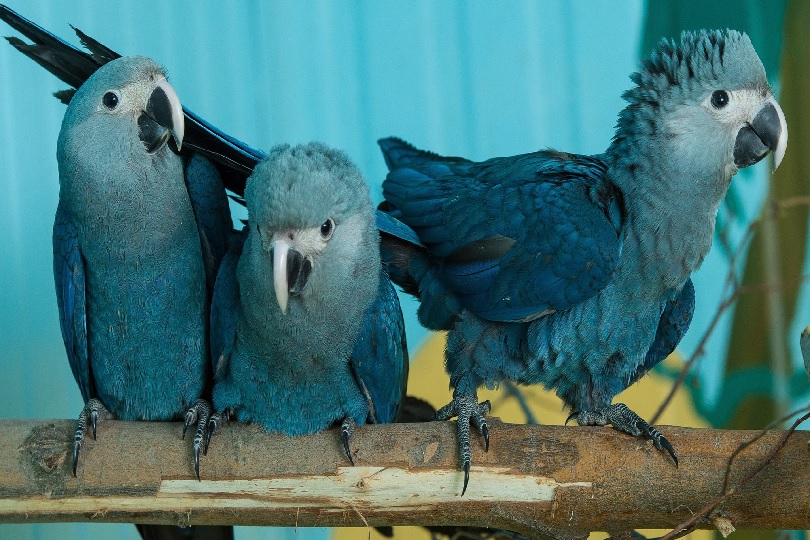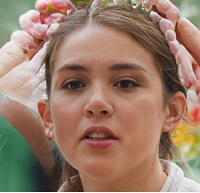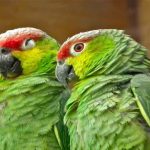In Rio, a flighty blue macaw named Blu (voiced by Jesse Eisenberg) flies from the U.S. to Rio de Janeiro because that’s where the last female blue macaw lives. Hijinks ensue, but Blu eventually develops feelings for Jewel (voiced by Anne Hathaway) and the movie ends with a thriving Spix’s Macaw population where once there was not one in sight! It’s a happy ending, but it’s one that is fiction and doesn’t have anything to do with the actual Spix’s Macaws.

A global partnership of organizations that work together to help animals and are trying to ensure the survival of endangered animal species around the world has determined that the Spix’s Macaw is officially extinct in the wild.
If you are looking for a macaw parrot price we have a detailed analysis on it you can check the details. If you are looking to learn more about parrots may visit for details.
A Little Blue Macaw: A Spix’s Macaw
A rare blue parrot species that was believed to have inspired the movie Rio has died in Sao Paulo. Spix’s macaw (Cyanopsitta spixii), also known as little blue macaw, is a macaw species that inhabited riparian Caraibeira (Tabebuia aurea) woodland galleries in the drainage basin of the Rio São Francisco within the Caatinga dry forest climate of interior northeastern Brazil.
Profile
Spix’s Macaw is easy to identify. It can be identified by the grey-blue of their face and their pupils as well as the pale blue grey of their frontal head. It’s about 56 cm (22 in) long, including a tail that can range from 26–38 cm (10–15 in). The wing span of these animals will range from 24.7–30.0 cm (9.7–11.8 in).
As mentioned above, it has vivid blue coloration on the top half of the body like its wings and tail whereas underneath it’s a slightly darker tone of grey-blue like on its face which is how it gets its name “Spix”, meaning Blue sparrow hawk in Portuguese or Blue Sparrow Hawk. The plumage of one male is identical to one female; there are no differences between genders except for size and weight with males being generally larger than females in captivity but this differentiation doesn’t occur ‘naturally’.
The legs and feet are brownish-black. In adults, the bare facial skin is grey, their beaks are entirely dark grey, and their eyes are yellow. Juveniles bear pale grey facial skin and have dark brown eyes (with a white stripe along the top-center of their beaks) until they reach maturity as opposed to adults who possess all black eyes.
Diet and Food
In the wild, Spix’s main source of food were Pinhão and Favela trees; however, as mentioned previously, these trees are not native to the Spix macaw’s homeland so they could not have been historical staples of its diet. As far as nuts and seeds, it also dined on Joazeiro , Baraúna, Imburana and Facheiro seed species. Asides from these sources of food that were the preferred choice for this bird in its natural habitat, it also consumed a variety of nuts and seeds from more diverse plant material including Phoradendron species (also known as the mistletoe tree), Caraibeira, Angico , Umbu tree leaves and Unha-de-gato (also known as catclaw).
Habits and Living Standards
In the wild, Spix’s macaws are sedentary, spending their days flying around with their mates in search of food. They can be seen along seasonal rivers where they eat and drink at different parts of the day before returning to their nests in treetops to spend the night there too. These birds are shy, so they will typically fly off when an intruder approaches. They are experts at mimicry and can quite easily mimic certain human voices (what is adorable)! Spix’s macaws tend to be noisy, active birds and make their “kra-ark cry” every few feet that they fly.
Distribution
The Spix’s macaw species was native to Brazil in northeastern parts of the state of Bahia and also in southern Piaui, between the montane savanna regions and the dry, scrubby Cerrado vegetation. Today they exist only in captivity, in populations that are scattered around the world. It is possible to find them in collections that are primarily found in private homes – but many have been placed into bird sanctuaries as well. Although this once abundant species has become extremely rare due to habitat destruction because of deforestation and capture for trade, it is still not listed on the IUCN Red List as an endangered species.
Breeding

Captive-bred endangered Spix’s macaws reach sexual maturity around seven years of age. A paired female born at Loro Parque Fundación laid eggs at the age of five, but they were infertile and it is suspected that late maturity may be due to inbreeding or other artificial environmental factors, as other parrots with similar characteristics reach sexual maturity in approximately two to four years.
In the wild, mating involves interesting rituals. Like for example feeding each other. This process may possibly take a few seasons in other large parrots and it may also be the case for them. They make their nests in hollowed out trees from Caraibereira that are filled with woodworm which provide protection from predators.
Breeding Season
During the breeding season, which is November to March, most eggs hatch in January around the same time that the Caatinga January to April rainy season begins. In nature, Spix’s Macaws are believed to lay three eggs per clutch. In captivity, the average number of eggs is four but can range from one to seven. It takes 25-28 days for incubation and only the female incubates her eggs. When the chicks are hatched they fledge after 70 days and become independent after 100-130 days.
RIO Parrot 15 Facts
1. The Rio Parrots are a species of parrot native to South America.
2. They are found in the Amazon Basin of Brazil, Peru, Bolivia and Venezuela.
3. The Rio Parrots are brightly coloured, with a green body and a red belly.
4. They are one of the loudest parrot species, and their call can be heard up to 2 miles away.
5. Rio Parrots are social birds, and live in flocks of up to 30 individuals.
6. They are mostly active during the day, and spend their nights roosting in trees.
7. Rio Parrots eat a diet of fruits, seeds and nuts.
8. They are known to mate for life, and nesting pairs will often stay close to each other even when not breeding.
9. The Rio Parrots are an endangered species, with an estimated wild population of just over 1000 birds.
10. The main threats to the Rio Parrots are habitat loss and capture for the pet trade.
11. Rio Parrots are protected by law in all range countries, and international trade in the birds is banned.
12. The Rio Parrots are the national bird of Venezuela.
13. The Rio Parrots are the only parrot species to have been featured on a postage stamp.
14. The Rio Parrots are the only parrot species to have their own Facebook page.
15. The Rio Parrots are one of the most popular parrot species kept as pets.
Little Blue Macaw Extinct In World
When describing the Spix’s Macaw, one of the first things that come to mind would probably be its striking blue color. As they say, beauty is only skin deep and this bird is proof of that statement. Underneath all those feathers lies a harsh reality – the fact that its not uncommonly known as the “blue macaw”, doesn’t mean it has been doing fine in its natural habitat as it has been endangered species since 1930 after being sighted by ornithologist Carl Von Spix in 1819 when he was exploring Brazil. Indeed, centuries of deforestation and land occupation were threatening their survival from the beginning of post-colonial times which preceded the decline in their population by almost 90%.
Based on a 2018 analysis, which considered the factors of time since last confirmed records, patterns of bird extinction, and threats faced by the species, it has been suggested that the bird is highly unlikely to be extant in the wild. As 2019 draws to an end, the IUCN lists this species as classed as being extinct in the wild.
Captive Population of Blue Macaw Till 2015
In June 2013 there are around 96 Spix’s macaws in captivity, 83 of which are participating in an international breeding program managed by the Instituto Chico Mendes de Conservação da Biodiversidade (ICMBio), the Natural Heritage Branch of the Brazilian Government.
Till end of 2015, Blue Macaw population reached upto 110 which was due to the reproduction plan. This count does not include the numerous birds that are kept in private hands.
| Institutions / Locations | Males | Females | Unknown | Total | Bred in captivity |
|---|---|---|---|---|---|
| Al Wabra Wildlife Preservation (AWWP), Doha, Qatar | 24 | 36 | 4 | 64 | 37 |
| Association for the Conservation of Threatened Parrots (ACTP), Berlin, Germany | 4 | 3 | 0 | 7 | 5 |
| Loro Parque Foundation (LPF), Tenerife, Canary Islands, Spain | 0 | 1 | 0 | 1 | 6 |
| NEST, Avaré, Brazil | 3 | 7 | 2 | 12 | 2 |
| (private owners), Switzerland | ? | ? | ~13 | ~13 | ~8 |
| Total | 31 | 47 | ~19 | ~97 | ~58 |
Reintroduction Plan for Blue Macaw Population

In June 2018, the population of the species numbered approximately 158 individuals and an agreement was signed between the Ministry of the Environment of Brazil and conservation organizations of Belgium and Germany to establish the repatriation by the first quarter of 2019. It is expected that they will be reintroduced within 2021 to the wild.
In August 2018, 146 of the 160 Spix’s macaws worldwide were living in the Association for the Conservation of Threatened Parrots in Rüdersdorf. 120 of 144 were from Qatar. Their housing situation there was undesirable so they were relocated following the death of the maintainer of the Al Wabra Wildlife Preserve, Sheikh Saud bin Mohammed Al-Than, in 2014 due to a national and economic embargo imposed on Qatar by Saudi Arabia, UAE and Bahrain in 2017. The goal is to produce about 20 macaws per year.
New Chicks Of Blue Macaw
In 2021, a stretch of land about the size of the State of Maryland near Brazil’s northeastern coast will be an important focal point for everyone involved with wildlife conservation. There, from April to July, three Spix’s macaws – birds that have been extinct in the wild since the year 2000 – will hatch and definitively prove that humans can use our ingenuity and determination to bring one of the loveliest animals *** ever created back to life. The process will take place at a 26-hectare nature reserve in the Caatinga region of Brazil called Primavera do Leste Biological Reserve, which is owned by Grupo Boticário de Proteção à Natureza S/A.
Some Facts You Must Know About Rio Parrot
- It is believed that a blue macaw may mate for life (remain with one female the whole life).
- Nests are constructed in the cavity of tree trunks, where they remain undisturbed throughout the monsoon season.
- These tropical birds rear their offspring during the rainy season, which extends from December to February.
- Macaws consume fruits, flowers, seeds and tree gum. They cannot digest big amounts of seed so they vomit it after eating; then one macaw regurgitates food into another’s mouth by using its beak.
- One of the reasons so many species of macaws are endangered is because large numbers are captured illegally for sale as pets or for zoos. Killing or hunting parrots is a crime in many countries and can make people go to jail.
Blue Birds From Rio in Details
Blu, a male Spix’s Macaw, thinks he’s the last living male of his species. But that is not the case, as he discovers when he meets Jewel, the last living female of his species. Since mixed species flights are illegal, Blu travels from Minnesota to Brazil to be with Jewel. The movie revolves around the various obstacles and adventures between the romance of Blu and Jewel, who both share a beautiful friendship.
The animated move “Rio” tells the story of Blu, a very rare Spix’s Macaw (the last male in existence) and his journey to mate with Jewel, the last female. These are the birds from rio and this movie is a very fun way to showcase the love between Blu and Jewel. They go through many hardships to stay together in the end, making it an interesting and engaging movie. The movie offers a few laughs, some action, and a lot of heart, so it’s a great movie to watch with the whole family.
Two blue birds Blu and Jewel ultimately fall in love, have a baby and the movie ends happily – with the hope that the literal lovebirds can save their species. In the real world, however, Blu would’ve been too late.
Two Blue Birds in Rio 2
Rio 2 is a sequel to Rio. In Rio 2, the blue macaws Blu (voice of Jesse Eisenberg) and Jewel (Anne Hathaway) have three children – Tiago (Pierce Gagnon), Carla (Rachel Crow) and Bia (Amandla Stenberg) – who are all enjoying growing up in Rio.
List of All Birds from Rio
In the animated film Rio, a Spix’s Macaw named Blu flies all the way from Minnesota to Rio de Janeiro because he’s the last living male of his species and that’s where Jewel, the last living female, lives. The film is a comical tale of their love growing after they meet. However, they soon get separated and Blu must travel to several different places to find Jewel and escape captivity in the process. They’ll face many challenges and learn valuable lessons along the way. Blu must learn how to coexist with other birds of his kind and befriend them as he prepares to save his species from extinction.
Following is the list of all birds from rio
Spix’s Macaw
Red-and-green Macaw
Blue-and-gold Macaw
Scarlet Macaw
Watch Rio Parrot Movie on Youtube
Conclusion
Spix’s Macaw (Cyanopsitta spixii), also known as the Little Blue Macaw, is a medium-size blue parrot native to Brazil. It weighs about 300 grams (11 oz.) and can be identified by its greyish-blue head, light blue underparts, and vivid blue upperparts. Males and females are almost identical in appearance, though the females are slightly smaller.
It is listed on CITES Appendix I, making international trade prohibited except for legitimate conservation, scientific or educational purposes. The IUCN states that the Spix’s macaw is extinct in the wild. Although there have been a few sightings since 2000, it has not been sighted in recent times. The species is currently maintained through breeding programs at conservation organizations under the aegis of the Brazilian government.

Bird Enthusiast
Masters in Counseling & Data Sciences
University of Maryland
Professional Parrots, Pigeons Breeder and Keeper








There is certainly a lot to know about this issue. I really like all the points you’ve made.
Blue Macaw Parrots Priceless Birds Rio Parrot – Parrots for Sale Thanks for writing it.